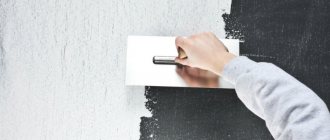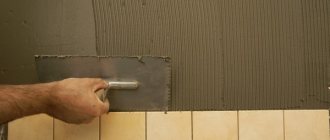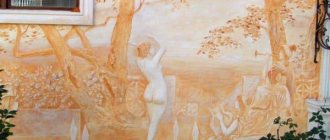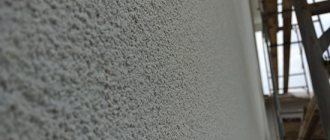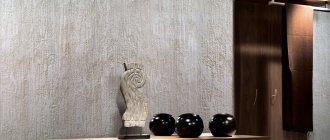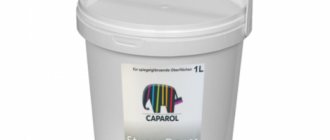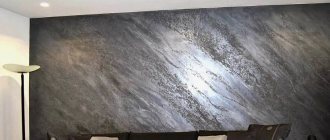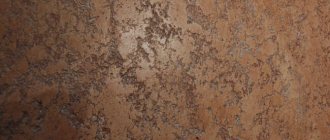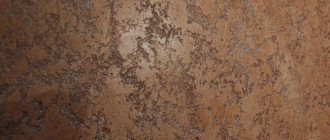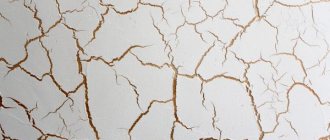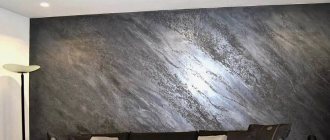The use of plaster combines two convenient directions at once. It protects from the negative effects of the environment and is a fairly simple decoration element to use. In the list of numerous offers from manufacturers, facade decorative plaster of the bolix mpka15dm type with a “porridge” structure is deservedly popular.
Decorative facade plaster for exterior work: photos and videos
In order to get, as a result of finishing work, not just a box for a Cheburashka, but a beautiful home (like a gingerbread house), you will need decorative facade plaster. She transforms the most dull home options into a unique and inimitable design, if you approach the process with taste and knowledge of the matter, using the right techniques, materials and stylistic solutions.
Types and compositions.
There are a lot of variations of facade plasters on the building materials market that can satisfy most consumer requests. Teams of professional chemists, designers and technologists representing various companies are working on this range. The whole variety of materials can be compared in the context of these manufacturers, for example, in this form:
- (Lamb, Fur coat); (silicone Venetian, pebble, Bark beetle, Mineral, Relief); (Bark beetle, pebble, mosaic);
- Bergauf (Fur coat, Bark beetle, pebble); (Fur coat, Bark beetle);
- Bolix Mpka15dm (mineral) and Perfecta plaster (Bark beetle).
Thus, the same company can produce several types of completely different plaster, which differ in two parameters - components and type of application. When divided according to laying technology, bark beetle, fur coat (lamb) and pebble plaster are separated into separate categories.
These are special compositions that differ significantly in technique and tools used. These types create a special texture, unique only to them, due to the presence of special components - particles of natural or artificial origin, of a given size and color.
The entire texture, similar to sheep's wool, is obtained due to the difference in the thickness of the sprayed layers. The situation is similar with other mineral plasters. They are also applied in thick layers and perform an additional function - insulation.
But even they are divided according to the main component:
- ; ; ; ; ;
- Mineral.
It is worth noting that gypsum mixture is used for exterior work in our latitudes extremely rarely, since it does not tolerate high humidity and large temperature changes.
The base can be colorless (transparent) or colored. The type of painting affects whether the composition will be used alone or with an additional coating such as facade paints on the same base. Accordingly, acrylic paints are used with acrylic mixtures, and silicone paints are used with silicone mixtures.
The silicone base in the composition is formed by a mixture of artificial polymers. The silicate base is liquid glass, but other options are obvious.
All such compositions are produced in the form of a semi-finished product (dry construction mixtures) and a finished product (silicone, silicate and water-based solutions).
Cost and average consumption.
Whatever the composition of the material, the first thing that interests the buyer is the price. It is a complex indicator consisting of many components that not everyone pays attention to. For example, prices for delivery services are an indirect indicator, however, they also play a role, so foreign mixtures cost an order of magnitude higher than domestic ones.
However, this is not the only factor that reflects the amount of money spent per square meter of coverage. Components, including fillers, play an important role. Polymer structural ingredients (balls, crumbs) are much cheaper than the same granite and marble that is used in stone versions.
The costs of manufacturing, development and marketing are also not the last component. Therefore, it happens that expensive facade plaster does not justify the investment in it.
But according to preliminary design calculations, it may also turn out that it is much more profitable to buy an expensive thin-layer composition, which is applied in a layer of 2.5-3 mm, than to order a cheap one, applied in a thick layer of 50-70 mm. The difference seems insignificant on the counter, however, if the area covered is very large per m2 multiplied by the total figure, the cost of funds increases exponentially.
Often per sq. m. of coverage will have to pay a hefty sum. From 8 to 10 kg of mixture is used per unit area. In this case, the unit of weight in terms of currency will vary from 1.5 to 10 $. Therefore, sometimes it makes sense to use another material for insulation, and make the finishing coating 2-3 mm thick in a thin layer.
Another expense item is finishing work. A self-respecting master will not charge less than 400 rubles per square meter of treated surface. Using a specific example per sq. m. of bark beetle laid on the facade will cost from 600 to 1500 rubles, depending on the complexity of the chosen texture, region and volume of work. So, it is much more profitable to cover the entire room than its individual sections.
Per m2 of plot up to 400 units. area payment is higher than the same plot, but on an area of 1000 units. However, it is always cheaper to buy the mixture and do all the work yourself.
If this is your first experience of this kind, it is better to order a team of workers who know how to work even with such a composition as a winter façade.
For outdoor use: how to choose and apply.
When choosing your own option, you may stumble upon the problem of the product not meeting the expected requirements. Not all of the proposed options meet the principles of repelling dirt, preventing the effects of moisture and meeting vapor permeability at the proper level.
Facade plaster for exterior work, how to choose it from all the variety. After all, an incorrectly selected mixture negatively affects the performance of its function and other auxiliary layers (waterproofing, vapor barrier), which causes signs of destruction of the base, deposition of salts on the surface and the development of pathogenic organisms.
The manufacturer indicates on the packaging exactly what aggressive factors the plaster can withstand. In addition to annual temperature changes and the humid coastal climate, these include fading of flowers during prolonged exposure to direct sunlight.
The most resistant to it are pebble and other mineral species that do not contain synthetic or organic dyes, but have their own rich color. Their range is quite scarce, but this is a necessary measure to save on annual surface painting.
If the area in which the building is located is exposed to anthropogenic factors, for example, gas or dust, it is important to choose a composition with antistatic properties. Otherwise, you will have to constantly wash off the dirt from the walls or cover them again and again with a new layer of decorative coating, wondering: which façade is better and solving it by brute force.
It should be remembered that there is a winter façade that can withstand frost better than others and also acts as insulation.
In general, species can be divided according to their inherent characteristics and features:
- Acrylic is the most budget option of all existing decorative coatings: they have a wide range of colors, but lose saturation over time;
- Silicate - are resistant to physical impact, but are very expensive;
- Cement and cement-sand – do not have sufficient decorative properties and require additional processing;
- Silicone - which are not afraid of water and are the best at repelling dirt, relatively expensive;
- Mineral - have better vapor permeability, do not always correspond to the taste preferences of the consumer.
Do it yourself.
Making your own store-bought mixture won’t be a problem. Do-it-yourself facade decorative plaster is not something out of the ordinary. The liquid-based composition just needs to be mixed until it has a homogeneous consistency. And in the case of a dry mixture, you only need to follow the instructions on the packaging, namely, mix the contents of the bag or package with water in a given proportion, which is where all the preparation ends.
As for the application process, the work should be carried out in dry, windless weather. This will ensure the best conditions. It is better to apply it yourself for outdoor work in the warm season. If you have to plaster in cold weather, you should take care of the characteristics of the composition. Because after a change in temperature, the coating may swell, crack or crumble.
In most cases, they resort to the use of additional components of the mixture that stabilize it, such as a soap solution. But it is better to use those coatings that can withstand tension and compression, as indicated on the packaging.
It is quite difficult to apply, especially if most of the operations are performed only manually without the use of additional equipment.
Therefore, it is necessary to correctly calculate the forces and distribute the processes over time. If your own strength is not enough, you should attract assistants or a professional team, otherwise the result of the work may turn out to be disastrous, and the implementation may be delayed.
It is worth noting that the application of decorative compounds, even outside, is carried out at least 28 days after completion of construction. In some cases, applying facade plaster for exterior work with your own hands is postponed for 2-3 years, because... The density of the surface coating is usually lower than that of the base, which can cause premature failure during shrinkage.
The only exception is silicone-based coating materials, since they have sufficient elasticity even after drying.
Supporting materials.
It is clear that decorative facade plaster alone will not save the appearance of the building and along with it you will have to buy a lot of additional materials, tools or even special construction equipment.
To get a result that deserves approval, you need to think in advance about what the finished coating will look like, how it will fit in with other façade elements, the roof and the surrounding landscape.
In order for everything to look as aesthetically pleasing and correct as possible, in addition to decorative mixtures, you will have to purchase starting leveling compounds, primers and material for the reinforcing layer such as corner profiles, plaster mesh, etc. You may also need masking tape, a tape measure, and a level. They will give the facade a marketable appearance.
But we shouldn’t forget about technology. In order not to violate it, you will have to use a number of mandatory attributes. Among the tools that are necessary for applying facade plaster for exterior work with your own hands are the following:
- Spatulas;
- Trowels; ; ;
- Measuring containers;
- Mixing containers;
- Ladder or scaffolding.
In addition, from the equipment that may be needed, it is worth highlighting:
- Mixing devices (mixers);
- Grinding devices; (sprayers).
You can apply facade plaster for exterior work with your own hands, but this will require solid experience in this matter. Therefore, it is better to have professionals do it.
Compatibility problem.
The peculiarity of external decorative compositions is that they combine well with any type of base. They easily lie on the surface being processed, regardless of what the source material is. Whether it is wood, brick or a concrete slab, if the technology is followed, the composition will stay on it for years.
Mixtures for external treatment such as Perfecta plaster differ from those used for interior finishing due to their greater adhesion and resistance to other factors. Therefore, it is rare to find those materials for interior treatment that work perfectly outside. Much more often, the opposite situation occurs when a decorative facade mixture is used for interior decoration of rooms, for example, with high humidity (bathrooms, washrooms).
As for some facade types, they can even be laid on insulating materials without preliminary finishing. In particular, there are options that are adapted for covering materials with specific properties, for example, polystyrene boards. They work well in combination with each other and complement each other's properties. In such cases we talk about facade systems.
Their cost may be slightly more expensive than individual assembled components, but in this combination they create ideal conditions for extending service life. However, the problem of facade plaster for exterior work cannot be ruled out; you need to know how to choose it based on its properties.
Alternatives and replacement methods.
Decorative facade plaster can be easily replaced with another material. At the moment, there are many other options that are not inferior to it in their qualities, and in some cases even superior to it. For example, there are a lot of sidings, sandwich panels, and other materials for exterior cladding that are much easier to combine with each other than different plasters. Although progress does not stand still, and special surprises can be expected in the near future.
Today, plasters, compared to past centuries, have grown in quality, and even if you put the compositions produced today next to the generation of the previous decade, the difference will be amazing.
Hybrid mixtures are already appearing that combine the best characteristics - cement hardness, moisture resistance from silicone or vinyl resins and vapor permeability from mineral and silicate mixtures. At the same time, they meet the requirements of safety and environmental friendliness, despite the fact that this category of materials has more lenient requirements compared to those used for interior decoration. But which is better in a particular case is up to the consumer to decide.
Criterias of choice
In order to determine which plaster mixture is best suited in a given situation, you need to pay attention to a number of factors. When choosing a plastering method, first of all you should pay attention to the annual amount of precipitation
When choosing a plastering method, first of all you should pay attention to the annual amount of precipitation. If the exposure to moisture is significant, thin-layer mixtures will have to be abandoned, and pebble plaster becomes the best option for decorating the facade - in this case, the coating will last much longer without the occurrence of emergency situations
If the exposure to moisture is significant, thin-layer mixtures will have to be abandoned, and pebble plaster becomes the best option for decorating the facade - in this case, the coating will last much longer without the occurrence of emergency situations.
It is also important to take into account the material of the supporting surface:
- for aerated concrete or shell rock, the most suitable option is silicate plaster;
- It is better to cover brick or cinder block walls with cement-sand or mineral;
- for woodworking, you should use silicone or acrylic;
- For penoplex insulation, special thin-layer mixtures are used.
If the building is located on the sunny side most of the day, preference is given to mixtures of natural materials, since synthetic ones may not be so durable.
As for the color palette, in this case it is better to choose neutral, calm tones; brighter options will lose their original color too soon.
You should never neglect the parameters specified by the manufacturer on the packaging: minimum layer thickness, mixture consumption, and constituent materials. This will greatly facilitate the choice and eliminate unpleasant situations.
Be sure to check the expiration date of the product. Unfortunately, this important point is overlooked by most buyers. Meanwhile, many components stop working over time or begin to act differently, which will certainly affect the quality of the work performed.
All the advantages and disadvantages of bolix mpka15dm plaster
Decorative plaster is the most common material for wall decoration. This is due to the low cost of consumables and exceptional performance.
What is it for? Quality of finishing material
Facade plaster has the following characteristics:
- Protection of walls from the destructive effects of weather conditions (wind, snow, rain). Observing this condition ensures normal air exchange between their internal and external surfaces.
- Suitable for all types of surfaces, including thermal insulation (expanded polystyrene, plastic, foam).
- Post-finishing of walls is varied. The unique color range of water-based paints allows you to change the color of the building to any color depending on the customer’s preferences). Rollers and shaped spatulas allow you to get a variety of prints on the finishing material.
Plaster is both a construction and finishing material.
Types of plaster
All finishes are divided into several types depending on the main component of the mixture:
Universal plaster Mineral Acrylic Silicate
- Silicone solutions are considered universal. This is due to the practicality of the material. It has heat, steam and water permeability. Resistant to mechanical stress. Dust does not settle on such coatings.
- Acrylic mixtures are quite durable. Withstands up to 20 years of maintenance-free operation due to the elasticity of the surface layer. Requires additional preparation of walls (leveling, priming).
- Silicate finishing material allows you to protect the surface of building walls for as long as possible. Excellent for residential and administrative buildings.
- Mineral facade plaster ranks first in the market of finishing materials for facades in the CIS. The popularity is due to the low cost of the product and excellent performance.
Characteristics of finishing material bolix
Bolix mpka15dm facade mixture is a mineral decorative putty. Serves to cover external walls, the top thin layer up to 2 mm creates a barrier between the surface and the environment. Bolix decorative plaster is produced in two colors: white, gray for subsequent painting.
The composition includes cement and sand, which in certain proportions make up a dry mixture. To improve performance, certain components are added to the basic elements.
Properties
Advantages of this type of finishing material:
- Low cost of raw materials;
- Excellent thermal insulation properties of the finished surface;
- Minimal prep work.
Disadvantages of mineral finishing:
- Short service life;
- Labor-intensive construction work;
- Long-term post-processing of facade surfaces.
Stages of finishing work
Before carrying out the main block of finishing work, it is necessary to prepare the surface:
- Level, degrease, sand;
- Putty with primary putty and primer;
- Allow the surface to dry for at least 6 hours.
Preparation of a bolix type solution involves mixing the required amount of water with the dry mixture. Mix with a construction mixer until the solution is uniform in color and consistency. After applying the solution in a thin layer to the surface of the walls, it should be evenly distributed over the base (with a plastic grater).
Using an up and down motion, apply the plaster until the same pattern is obtained.
Decorative textured coating Bayramix Decostone fine 15 kg color white
We deliver goods directly from partners from all over Russia. These products are not presented in stores and are only available for ordering on the website.
Art. 82879072 Fraction size (mm) 2 3.0 In the shopping list In the shopping list In comparison In comparison
Available for this coverage
To select and obtain a color code, use the Palette. Order a tinted coating, indicating the color code you like in the delivery comments.
Please note that ordering tinted coating is only available with 100% prepayment. Textured coating Bayramix Decostone - a textured coating based on acrylic copolymers with a large mineral filler with a “bark beetle” effect
Suitable for exterior and interior use. Used to create decorative coatings on building facades, columns, friezes and other architectural elements
Textured coating Bayramix Decostone is a textured coating based on acrylic copolymers with a large mineral filler with a “bark beetle” effect. Suitable for exterior and interior use. It is used to create a decorative coating on building facades, columns, friezes and other architectural elements.
It is also recommended as a decorative coating when installing “wet façade” external thermal insulation systems.
Properties:
- Performs decorative and protective functions
- Hides minor surface defects
- High mechanical strength and elasticity
- Weather resistant
- Environmentally friendly
- Vapor permeable
- Fireproof (fire hazard class KM1)
Preparing the base:
When applying Decostone, the surface must be dry, smooth and clean. All oils, dirt, organic matter and loose old coatings must be removed. Treat the surface with deep penetration primer Primer AstarFix Bayramix. Complete the preparation of the base with Bayramix Astar Quartz covering primer, pre-tinted to match the color of the decorative plaster.
Application:
Before using the material, mix the contents of the bucket thoroughly. Tint if necessary. It is allowed to add water up to 2% of the total mass. During the application process, the material must also be stirred periodically.
Apply Decostone using a stainless steel trowel or a rubber-coated float (optional) to the thickness of the coarse filler grain. Set the pattern with a plastic trowel, slightly moistened with water, when the material no longer sticks to the tool (after 5-10 minutes).
Depending on the direction of movement of the tool, you can get circular, unidirectional or cross grooves - they are formed when large filler grains move.
To avoid the formation of visible joints on the coating, it is recommended to apply Decostone in one pass using the “wet on wet” method, from corner to corner.
Fine fraction – 1.2 – 2.0 mm
vote
Article rating
Characteristics of Bolix mpka15dm facade plaster
The use of plaster combines two convenient directions at once. It protects from the negative effects of the environment and is a fairly simple decoration element to use. In the list of numerous offers from manufacturers, facade decorative plaster of the bolix mpka15dm type with a “porridge” structure is deservedly popular.
Content
Where is this plaster used?
Decorative plasters of the Bolix brand are the most popular and in demand type of mineral decorative putty on the market. The use of Bolix MPKA15DM with a “porridge” structure is recommended when covering with a thin layer to create a coating layer that protects the facade from direct contact with the negative influence of the environment. Can be used for decorative finishing of external surfaces, and used when decorating the interior space of premises.
When used, façade plaster bolix mpka15dm successfully hides minor defects in façade finishing:
- cracks and chips;
- unevenness;
- uneven painting in corners and others.
The favorable price per kg is attractive when processing surfaces of large areas. Designed for manual application in a thin layer. The advantages include a combination of low cost and ease of operation. The downside is the fragility of the coating layer.
Technical characteristics of Bolix MPKA15DM
Facade plaster bolix mpka15dm belongs to the category of mineral finishing materials. It is made from natural and environmentally friendly components, allowing use not only for finishing the facade, but also for interior spaces.
This type of decorative plaster is produced in white and gray colors. The use of gray is intended for further decorative painting in other colors. The white surface of the façade is preserved without additional processing or finishing.
It is produced in the form of a dry mixture, which includes sand and cement. Contains specialized binding components. Includes granular grains up to 1.5 mm. The composition is economical in consumption. It ranges from 2.8 to 3.5 kilograms per square meter.
Bags weighing 25 kilograms are offered for sale. To create the mixture you will need to use 4.5 to 4.8 liters of water per bag. Granulation is maintained when mixing using construction equipment. Most often, a specialized mixer is used.
Finishing technology
Applying a finishing layer yourself involves the need to first carry out quite complex preparatory work.
At the first stage, you will need to carefully treat the surface of the facade. Contaminants are removed. In cases where plaster is not being applied for the first time, the entire surface is carefully tapped with a hammer. This will make it possible to identify voids and cracks at an early stage that could later become a significant defect. Identified areas of voids and cracks are cleaned. They will need to be processed and sealed with building compound.
During the inspection, grease stains or oily stains will also be detected. They can interfere with the connection of the plaster layer to the surface. Such surface fragments are cleaned with fine-grain sandpaper. Dust will also need to be brushed off thoroughly. After preliminary measures, the facade is ready to apply the first thin layer. The technical characteristics of the surface meet the requirements for future painting. Facade plaster bolix mpka15dm is offered by the manufacturer with instructions for application. A quality product must have a certificate of conformity. Before applying the first layer, a primer coat is applied. To prepare the solution, the dry mixture is mixed with water. A construction mixer is used for mixing.
Mineral finish is applied in 3-6 layers. When used as decoration, it is possible to use mixtures of two shades. When applied sequentially, a beautiful, even shade is obtained. After completion of the work, the finished facade also needs to dry for 12 hours.
Advantages and disadvantages of the material
Among the advantages of this brand of plaster are:
- ease of use;
- favorable price;
- simplicity of preparatory work;
- long-term retention of elasticity after kneading;
- decorative properties;
- high thermal insulation characteristics.
The simplicity of this finishing material allows independent use, allowing, if you follow the instructions for bolix mpka15dm façade plaster, to make a batch and apply it to the walls outside and inside the house, even for those who have not previously encountered such work.
The disadvantages inherent in mineral compositions include fragility. Restoration of the façade coating will be required quite often, once every 2-3 years. If small defects appear, the damaged layer can be restored. It is enough to apply a kind of thin “patch” to the damaged area. Before performing restoration, the treated area will need to be thoroughly cleaned and degreased. Complete restoration of a building facade or a painted wall is carried out only after removing the entire layer that originally existed.
How to plaster the facade of a house with your own hands?
The plastering process is quite long and includes a number of sequential works.
If you are going to prepare the mixture by hand, you should only use separate buckets for water, sand and cement. This way the solution will be homogeneous and without unnecessary impurities.
Preparation of the solution
Standard proportion for cement-sand plaster: 4 units of cement to 1 sand. Both piles should be placed opposite each other on a mortar board or in a trough.
Using a shovel, transfer small portions and stir the mixture until completely homogeneous. Then a funnel-shaped depression is formed in the center, which is filled with water.
Using a shovel or other tool, add the dry mixture into the water in small portions and mix thoroughly.
The finished plaster solution should be creamy, homogeneous, and free of lumps and debris.
If you plan to use factory-made dry mixtures, then in this case it is necessary to strictly follow the manufacturer’s instructions, which are indicated on the packaging or on the insert included in the kit.
As a rule, the matter is limited to simply placing the dry mixture in a trough or on a mortar board and mixing it with water.
Do not forget that in both cases the volume of the finished solution should not exceed the amount that you can process in about one hour, otherwise its properties will change, which will greatly affect the result.
Quality checking
In order to evaluate the consistency of the plaster solution, you need to “cut” its surface with a shovel to a depth equal to approximately half the blade.
If the edges of the furrow crumble, there is too little water in the solution, add it in small portions, mixing the entire volume completely each time.
If the edges of the furrow are swollen, the solution is too liquid, and it is brought to the required consistency by adding cement.
Basic surface preparation
At this stage, all convexities of the bearing surface are eliminated using a chisel or sharpening stone. For better adhesion of the mortar to the wall, you can use a mounting mesh or wire stretched over pre-hammered nails.
To make work easier, you can use “beacons” - slats with a thickness equal to the required thickness of the plaster, which are attached at a distance less than the width of a spatula or other working tool.
It is important that they are at the same level, which is established using the rule. Before applying the solution to the wall, it should be washed with water.
This will remove all small debris and moisten the wall, which will provide better adhesion.
Applying the mixture
The process of applying the solution occurs in 3 stages:
- Spraying is a rough application of plaster by “throwing” it onto the wall using a trowel or spatula. The recommended layer thickness is at least 3 mm, but the solution may be more liquid. The task of this stage is to fill the recesses with the solution and ensure adhesion of subsequent layers.
- Leveling is a more precise application of the solution followed by leveling using “beacons” or rules. The recommended layer thickness is about 5 mm, the consistency of the solution is standard.
- Covering is the formation of the outer layer. It is at this stage that the final leveling or application of the decorative layer occurs. The recommended thickness is no more than 5 mm. For best results, a drier solution should be used.
It must be remembered that to ensure a sufficient level of vapor permeability, the outer layer of plaster must be 50% thinner than the inner one.
Now you know enough about plaster mixtures and you can easily determine which one to choose in your case.
Watch the following video to see how to plaster correctly:
BOLIX MP KA 15 DM
Mineral plaster MP KA 15 DM is used for decorative and protective thin-layer plastering inside and outside buildings. It is a wonderful combination of modernity and time-tested traditions. Thanks to the optimal formulation, mineral plaster with a grain texture creates a 1.5 mm top layer with high vapor permeability and resistance to atmospheric factors. Produced in the form of an enriched dry mixture. It is used in seamless insulation systems on polystyrene foam, as well as on smooth and properly prepared mineral substrates (such as, for example, concrete, cement and lime-cement plasters). The plaster is available in gray color. Before applying BOLIX MP KA 15 DM mineral plaster, the base should be primed with white BOLIX OP plaster primer.
Tanilite RS10 – 25 kg
Plaster STROYBRIG TANILIT PC10 is intended for leveling walls and bases made of concrete, brick, foam and aerated concrete. Recommended for finishing facades above the basement and rooms with any degree of humidity. For manual application. Can be applied using a mortar pump. For interior and exterior use. The high strength of the STROYBRIG TANILIT PC10 plaster layer allows it to withstand high operating loads, ensuring the reliability and durability of plastering work. The plasticity of the STROYBRIG TANILIT PC10 solution ensures convenience and ease of working with the material. The weather resistance and frost resistance of the plaster retain all the declared performance properties of the material when exposed to natural factors. The plaster is environmentally friendly and does not contain harmful impurities that have a negative impact on human health. Complies with the hygienic standards in force in the Russian Federation.
RECOMMENDED GROUNDS:
Concrete, brick, foam and aerated concrete bases, cement plasters
Instructions for carrying out repair work:
Preparation of the base: The base for plastering work must be strong, dry and clean. The age of concrete, cement-sand, cement-lime bases must be at least 28 days. Remove from the surface dust, oil stains, salts, peeling and crumbling elements of the previous coating, and other contaminants that prevent the adhesion of the material to the surface. The size of the level difference is checked in all directions using a building level or plumb line. The size of the drop affects the choice of material to be used. Treat the surface with Stroybrig Tanilit PC20 plaster spray. Install the beacons: secure the profiles in a vertical position; Screw in dowels along the edges of the profiles slightly above the planned wall plane; pull the nylon thread, securing it to the dowels. The distance between beacons should not exceed the length of the rule. The quality of wall alignment depends on the quality installation of beacons. Attach the plaster mesh to complex elements of building structures, corners and joints to reinforce the applied layer of mortar. Reinforcement will reduce the risk of cracks due to uneven settlement of the building. The base is ready for applying plaster only after the plaster spray has completely dried. Avoid contamination of primed surfaces. Preparation of the solution
To prepare the solution for machine application, it is necessary to pour the dry mixture into the hopper of a plastering machine. By adjusting the water flow, select the required consistency of the solution. This proportion should be remembered so that subsequent batches of the solution are prepared in the same way. The solution in the hoses and mixer should not remain stationary for more than 15 minutes.
Application
The solution is applied to the surface to be plastered in the direction from left to right and from top to bottom. The mortar gun must be held perpendicular to the surface to be treated at a distance of about 30 cm. When moving horizontally, the gun should be moved so that the plaster spray is directed at the lower edge of the already applied mortar. The application of a layer of solution is carried out in vertical stripes about 70 cm wide. Each subsequent strip must be applied overlapping the previous one by 5-10 cm on the left side. Depending on the thickness of the plaster layer and the state of the temperature and humidity environment, it is necessary to level the solution using the rule within 40-60 minutes after application. After 6-8 hours, it is necessary to trim the surface, removing all local irregularities using the trapezoidal rule, for final geometric alignment. To obtain a smoother surface, after trimming the surface should be slightly moistened and rubbed until smooth with a wooden or polyurethane trowel. Applying an additional layer of plaster is possible after the previous one has dried (after about 24 hours). During work and in the next two days, the temperature of the air and the surface of the base should not be lower than +5ºС and not higher than +30ºС, the air humidity in the room should not exceed 70%. During the hardening process of the applied plaster, the surface must be protected from intense drying: avoid exposure to direct sunlight and exposure to drafts. For final leveling of the surface, if necessary, it is recommended to use appropriate Stroybrig putties.
Recommendations
When working, use special clothing and personal protective equipment for the respiratory system, vision, and skin. If the solution gets into your eyes, rinse them with plenty of water and consult a doctor. After performing plastering work, the hopper of the plastering machine and the tools used must be thoroughly washed with water, preventing the solution from hardening on them.
BOLIX MP KA 15
Mineral plaster MP KA 15 is used for decorative and protective thin-layer plastering inside and outside buildings. It is a wonderful combination of modernity and time-tested traditions. Thanks to the optimal formulation, mineral plaster with a grain texture creates a 1.5 mm top layer with high vapor permeability and resistance to atmospheric factors. Produced in the form of an enriched dry mixture. It is used in seamless insulation systems on polystyrene foam, as well as on smooth and properly prepared mineral substrates (such as, for example, concrete, cement and lime-cement plasters). The plaster is available in white. Before applying BOLIX MP KA 15 mineral plaster, the base should be primed with white BOLIX OP plaster primer.
German development
German developers from the Fraunhofer Institute for Silicate Research ISC took a slightly different approach to creating a moisture-controlled finish. As an experiment, they included microparticles of porous Vycor glass into the plaster. This inexpensive component has shown an extremely effective result in maintaining optimal moisture conditions in highly airtight residential premises.
Advantages of porous glass
According to the experts who took part in the study, porous glass is an ideal additive for plaster. They attribute this to the fact that the size and shape of the particles contained in it can be selectively controlled.
The exact parameters of inorganic elements at the time of production can be set in the range from nanometers to micrometers. This precision allows you to effectively regulate the level of humidity in the room.
“Flakes” of silicate glass quickly absorb moisture from the air, retain it for some time, and then return it to the space. It can be noted that the general principle of operation is similar to the Swiss development.
Experiments have shown that the efficiency of porous glass compared to its alternatives (zeolite, fiberboard, etc.) is significantly higher. So, for example, if you plaster a room where the area of the ceiling and walls is 40 square meters. m., it will be possible to reduce the humidity from 72% to 47%, while the material will absorb about 180 ml of moisture. And plaster with glass particles under the same conditions can absorb up to 500 ml.
New in-demand materials for construction regularly appear on the market. But not every material can please the buyer with environmental friendliness, affordability and efficiency. Plaster with moisture-absorbing properties is one such rare product.
BOLIX DECO
Ambient and substrate temperature during application and curing: +5°C to +25°C.
Plaster drying time: min. 24h. Packaging: buckets: 15kg, 30kg.
Technical map:
Product Description
Used to make decorative and protective thin-layer plaster coatings that imitate natural stone inside and outside buildings. Contains carefully selected compositions of natural and artificial crumbs, giving the surface a spectacular and elegant look. High resistance to mechanical damage allows us to recommend the product for finishing plinths, pilasters, cornices and wall panels, for example in entrances. The plaster is characterized by high vapor conductivity and is resistant to the development of fungi and algae on the surface. Its use makes it possible to simply and easily obtain plaster in a wide range of colors (the palette of BOLIX DECO plasters is 48 colors). Used for finishing decorative surfaces and architectural details on smooth and properly prepared mineral substrates (for example, concrete, cement and cement-lime plasters, plasterboards, profiles and decorative columns).
Application methods
According to the method of application, plaster can be divided into structural and textured. Structural plaster is intended for preparing walls for decoration or eliminating gross surface defects.
Textured - is decorative in nature and, in turn, can be applied in different ways to give the surface decor.
Decorative textured plaster has the following types:
- Bark beetle - made on a foam base, in appearance it resembles a tree, streaked with passages of beetles.
Lamb - stone chips are used as a filler; in appearance it resembles sheep skin.
Fur coat is the cheapest and most common type of decorative plaster. The plastered surface is covered with small lumps, which, when white dye is added to the composition, looks like a layer of cotton wool.
Pebble (flock) - it is performed quite complexly and for a long time, in several stages (surface preparation, application of small pebbles or insoluble particles, varnish treatment), but as a result it leads to a very interesting appearance, reminiscent of a solid piece of stone.
Mosaic is a type of pebble, but in this case the filler fits together more tightly, which creates a mosaic effect, which is easy to see in the photo.
Marble is a type of mosaic, where marble chips of various calibers are used as filler.
Crocodile - performed using special textured rollers or stamps. In combination with a well-chosen color scheme, it creates the effect of leather covering the walls.
Dowel for thermal insulation Tech-Krep IZR 15x50 A 200pcs UT-00013331
- Length: 50 mm
- Diameter: 15mm
- Packing: 200
All characteristics
Price per pack of 4 pcs.: RUB 2,836. Price per one. product: 709 rub. 804 rub.
Write off up to 322 rubles. bonuses We will award 8 bonuses
- In your city: 1 pc. In stock: 1 pc.
- Pickup: tomorrow, after 17:00, from 1 store
- By courier: October 4, from 190 rub.
Technical characteristics of the Tech-Krep dowel
- *The manufacturer reserves the right to change the characteristics, appearance, configuration of the product and the place of its production without notifying the dealer. The information provided is not a public offer
Found an error in the description?
This product is from selections
- Dowel with thermal head
- Large
- 50 mm
- Russia is the birthplace of the brand
- China - country of production
Packaging information
- Product unit: Piece
- Weight, kg: 2.00
- Length, mm: 300
- Width, mm: 260
- Height, mm: 180
Service maintenance
We will help you solve any problem with the product
We will fix any problem under warranty. The period indicated does not include logistics
Contact the manufacturer's authorized services for service.
Reviews of dowels for thermal insulation Tech-Krep IZR 15x50 A (200 pcs.) UT-00013331
Questions and answers about dowels for thermal insulation Tech-Krep IZR 15x50 A (200 pcs.) UT-00013331
Have questions about the product?
Consumables for dowel Tech-Krep IZR 15x50 A (200 pcs.) UT-00013331
Ways to receive goods in Moscow
Pickup
tomorrow, after 17:00, from 1 store
Courier delivery
October 4, from 190 rub.
Transport company
Calculate shipping cost
- Requisites
- Franchise
- Social activity
- Information for investors
- Certificates
- Manufacturers
- legal information
- Sale
- Our promotions
- Sets
- For suppliers
- Organizations
- Franchise
- Courier delivery
- Delivery by transport company
- Pickup
- Payment Methods
- Service center VseInstruments.ru
- Support of requests
- Feedback
Work with us
You accept the terms of the privacy policy and user agreement each time you leave your data in any feedback form on the VseInstruments.ru website
